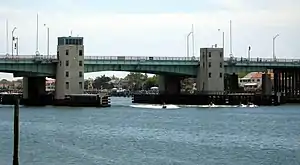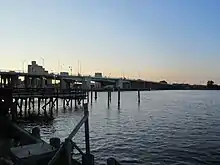Atlantic Beach Bridge | |
|---|---|
 | |
| Coordinates | 40°35′36″N 73°44′14″W / 40.59333°N 73.73722°W |
| Carries | 6 lanes of |
| Crosses | Reynolds Channel |
| Official name | Atlantic Beach Bridge |
| Owner | Nassau County Bridge Authority |
| Maintained by | Nassau County Bridge Authority |
| Preceded by | Atlantic Beach Bridge (old) |
| Characteristics | |
| Design | Bascule girder |
| Material | Steel |
| Total length | 1,173 feet (358 m) |
| Clearance below | 33 feet (10 m) |
| History | |
| Construction start | October 14, 1950 |
| Construction end | May 10, 1952 |
| Construction cost | $9.5 million |
| Opened | May 10, 1952 |
| Statistics | |
| Toll | $3 (E-ZPass), $4 (cash) |
| Location | |
The Atlantic Beach Bridge is a 1,173-foot (358 m) long toll drawbridge carrying NY 878, connecting Lawrence and Atlantic Beach (Park Street), New York, while passing over the west end of Reynolds Channel. The bridge also provides direct access to the Rockaway Peninsula via Seagirt Boulevard. The original bridge opened in 1927, and the current bridge opened in 1952 and was rehabilitated in 1998.
Typically, the toll is $3.00 (USD) with E-ZPass for vehicles under 5 tons (10,000 lb) in each direction as of December 2023. Cash tolls for vehicles under 5 tons are $4. An annual pass is $162 for Long Beach Barrier Island residents, $199 for Nassau County residents and $349 for non-resident passenger vehicles.[1][2] Toll rates for commercial vehicles are higher.[3]
Atlantic Beach is the only bridge managed by the Nassau County Bridge Authority.
History

The original bridge opened on June 29, 1927, and had a vertical clearance of only 13 feet (4.0 m). The bridge reduced travel time to Atlantic Beach by 30 minutes. Traffic bottlenecked as populations grew on both sides of the bridge in the 1940s. On October 14, 1950, Governor Thomas E. Dewey drove the first pile for the new Atlantic Beach Bridge.[4] To accommodate the new six-lane span, Nassau County and New York City spent $2.5 million for approach road rights-of-way. The new Atlantic Beach Bridge, designed by Hardesty & Hanover, opened to traffic on May 10, 1952, at a cost of $9.5 million. Soon after the new span opened, the old bridge was demolished. The new span is 1,173 feet (358 m) long with a 33-foot (10 m) vertical clearance.[5][6][7]
In 1998, a $19 million project was begun to bring the bridge up to federal standards. It involved the reconstruction of the approaching roadways and replacement of the existing concrete bridge deck. The project was completed in November 2000.[5]
There have been allegations of patronage since the inception of the Nassau County Bridge Authority, which was created by the New York Legislature in 1945 to manage the bridge. Though the construction costs of the bridge have long since been paid off, the tolls remain. A 1999 audit of the agency by New York State Comptroller Carl McCall found many instances of patronage and mismanagement. The authority failed to seek competitive work for engineering work. In 1997, 71% of the bridge's budget was spent on personnel. The authority and local communities continued to resist toll conversion to E-ZPass.[8] One community leader believes the resistance is not based on costs but because this would necessitate accounting of toll monies.[9]
Toll collection was temporarily suspended in mid-March 2020 due to the COVID-19 pandemic in New York.[10] Tolls were reinstated at the beginning of June 2020.[11]
In late December 2022, the Nassau County Bridge Authority voted to implement E-ZPass; concurrently, it raised tolls for the first time in fifteen years to provide funding for maintenance.[12][13] The E-ZPass equipment was expected to cost $5 million, and a renovation of the toll booth was to cost another $6 million.[14] The toll increases faced some local opposition, but the Nassau County Bridge Authority said in 2023 that it would not raise tolls for another ten years.[15] The bridge started accepting E-ZPass on December 14, 2023, after a week of testing.[2]
See also
- Bayville Bridge – Another drawbridge in Nassau County.
References
- ↑ "Ezpass – Passenger". Nassau County Bridge Authority. December 14, 2023. Retrieved December 14, 2023.
- 1 2 Asbury, John (December 12, 2023). "E-ZPass accepted at Atlantic Beach Bridge starting Wednesday". Newsday. Retrieved December 14, 2023.
- ↑ "Ezpass – Commercial". Nassau County Bridge Authority. December 14, 2023. Retrieved December 14, 2023.
- ↑ "K1604". NY State Senate. October 3, 2015. Retrieved April 7, 2020.
- 1 2 Atlantic Beach Bridge, NYCRoads.com. Accessed October 29, 2007.
- ↑ "Atlantic Beach Bridge; New Long Island Structure to Be Officially Opened June 29". The New York Times. June 26, 1927. p. E10. Retrieved April 13, 2010.
- ↑ Kihss, Peter (May 11, 1952). "New Span Opened at Atlantic Beach". The New York Times. p. 55. Retrieved April 13, 2010.
- ↑ Marko, Tyler (November 22, 2017). "Atlantic Beach Bridge renovation is on schedule". liherald.com. Retrieved October 1, 2019.
- ↑ Ain, Stewart (July 25, 1999). "Atlantic Beach Bridge: Tolls, Jobs and Politics". The New York Times. Retrieved October 29, 2007.
- ↑ Bessen, Jeff (March 16, 2020). "Nassau County Bridge Authority suspending toll operations at Atlantic Beach Bridge". Herald Community Newspapers. Retrieved August 12, 2020.
- ↑ Bessen, Jeff (June 1, 2020). "Atlantic Beach Bridge tolls are in effect, again". Herald Community Newspapers. Retrieved August 12, 2020.
- ↑ Schwach, Ryan (December 9, 2022). "Atlantic Beach Bridge Toll To Double In 2023". The Wave - Rockaway's Newspaper since 1893. Retrieved November 9, 2023.
- ↑ Valenti, John (December 6, 2022). "Atlantic Beach Bridge toll to rise to $3 on Jan. 1, a 50% increase". Newsday. Retrieved November 9, 2023.
- ↑ Galdamez, Hernesto (April 2, 2023). "E-ZPass is 'well on its way' at Atlantic Beach Bridge". Herald Community Newspapers. Retrieved November 9, 2023.
- ↑ "Protesters call for reversal of Atlantic Bridge toll increases, audit of Bridge Authority's finances". News 12 - Long Island. September 28, 2023. Retrieved November 9, 2023.